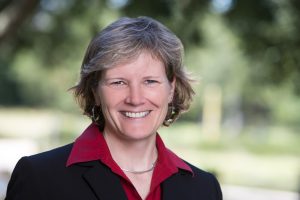The Hewlett Foundation’s Organizational Effectiveness (OE) program, created in 2004, seeks to help the foundation’s grantees be high-performing organizations, making their work – and ours – more likely to succeed. OE provides small grants to build grantees’ internal capacity in areas like strategic planning, board development, fundraising, and communications. In 2014, the foundation commissioned Social Policy Research Associates to conduct a first-ever evaluation of the program. The report was completed last November, and OE staff have spent much of 2016 applying what they learned. Lori Grange, Strategy and Organizational Effectiveness Officer, explains more.

Lori Grange of the Hewlett Foundation’s Effective Philanthropy Group
You asked the evaluators to assess what value, if any, OE grants add to grantees’ and the foundation’s work. What did they find?
OE grants are pretty small – on average, $40,000 over one year – but they punch above their weight. The evaluation found that, by and large, these grants deliver what they promise in the near term: solid strategic plans, fundraising campaigns, leadership transition plans, and so forth.
OE support has additional benefits, according to surveys of program staff and grantees. The grants help organizations’ leaders prioritize, justify and support capacity-building projects that otherwise likely would go to the wayside. They enable organizations to engage consultants to provide specialized expertise and fresh, independent eyes. As program officers and grantees collaborate on the proposals, they build mutual trust and understanding.
We’ve operated with the belief that OE support also will have positive, broader and longer-term impact on grantees. But the evaluators could neither prove nor disprove this hypothesis. Many other, more significant factors come into play for organizations as time passes after the OE grant term. Other capacity-building funders are vexed by this question.
Did you learn what makes an OE grant successful?
Three things are key, according to the evaluation. First, grantees have to be ready to take on capacity-building projects. That means their leaders, board and staff must be committed to making the work a priority, among other things. Second, a grantee’s consultant must be a good fit—highly knowledgeable about the relevant field, flexible, accessible, and able to build rapport. Third, when program officers understand their grantees’ needs, help them put proposals together, and provide ongoing support of the projects, it can make a critical difference. That’s consistent with what others in the field have found.
We were surprised by what doesn’t seem to predict a grant’s success. Nothing in the evaluation suggested that one type of project—strategic planning, for example—is substantially more successful than others. Factors such as grant size, grant term, and the grantee’s overall budget and staffing size also aren’t predictive.
What did the evaluation tell you about what’s working and what’s not in the OE program?
Program officers generally believe they are fairly well prepared to identify and support their grantees’ capacity-building needs. They value the OE staff’s assistance, from providing consultant referrals to advising how projects can be shaped. In fact, so far this year, more than 60 percent of current program directors and officers have requested and received guidance.
Program officers told evaluators – and we’ve heard this directly – that they want more support and more opportunities to learn from their colleagues. We’ve fallen short on providing peer-to-peer learning opportunities and trainings. Limited bandwidth is a big factor: A program associate and I each devote 50 percent of our time to OE.
Finally, both program staff and grantees asked for more flexibility about how OE grants can be used and what they can pay for– for instance, when it’s reasonable to cover grantee staff salaries and benefits.
What changes have you made as a result of these findings?
We’ve been exercising a lot more flexibility with OE grants this year to better meet grantees’ needs. We also are exploring the feasibility of a pilot project in 2017 that would focus on OE support for building grantees’ internal capacity in the area of diversity, equity, and inclusion. This is driven both by evaluation results reflecting a desire among program staff and grantees for greater flexibility and by growing interest in this particular line of work.
We’ve also commissioned a review of tools that nonprofits and funders can use to assess organizations’ health and capacity needs. This can help inform the foundation’s due diligence in all of its grantmaking, not just OE. We’ll share what we learn with the field.
In 2017, we’ll provide more opportunities for staff to learn from one another. We’ll also be focusing on improving how we collect and use data so we can better understand the needs, intentions, and effects of the OE grants and make real-time adjustments.
